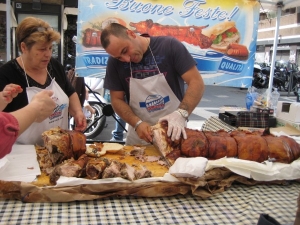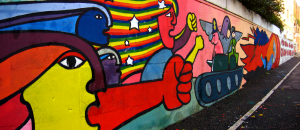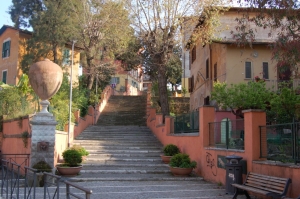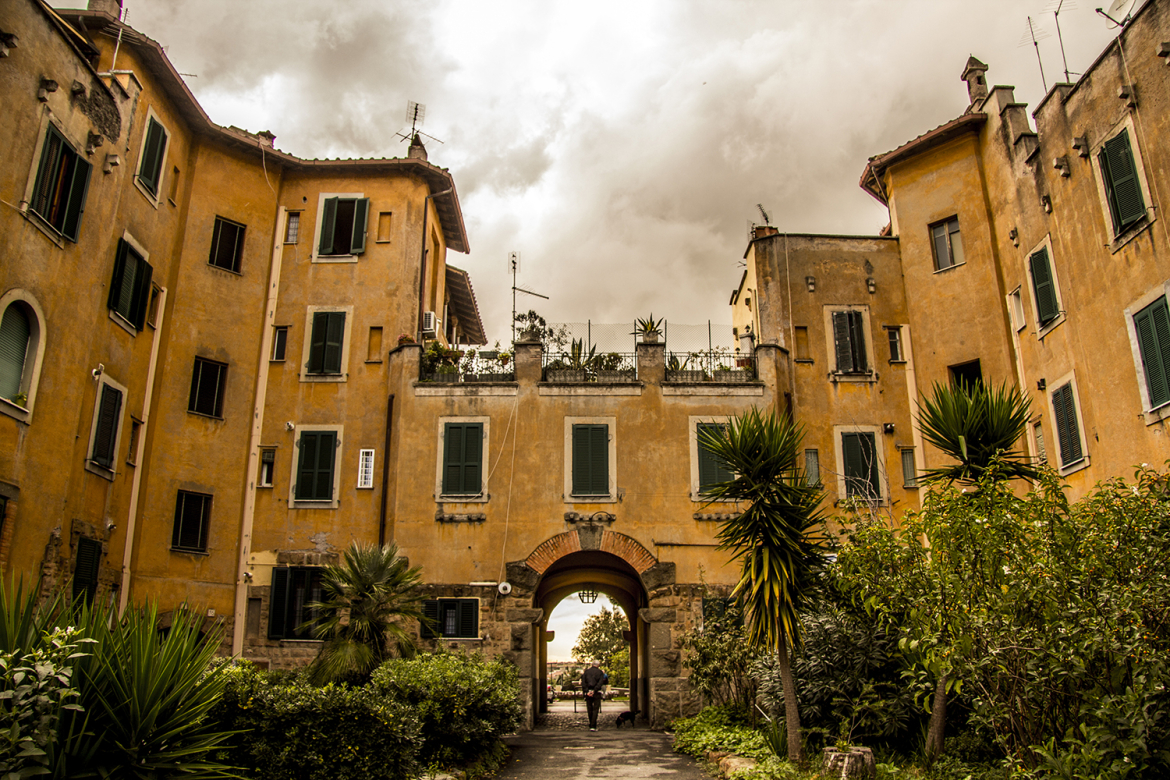The Gardens of Garbatella
Each of the first three times I visited Rome the old city center pulled me in like a magnet. For these journeys I was staying in a rented apartment in the north of Rome, in the rione of Prati. The neighborhood is situated across the Tiber River from the old city center. From this starting point I would leave my building every morning and my body (via muscle memory) would be steered south across the Ponte Sant’Angelo.
There was very little thought involved. The rambling cobblestone lanes of old Rome call upon every visitor to the eternal city. This is where Rome’s most important monuments and works of art are held. It is also delightfully walkable but tangled enough to lose yourself there for years on end. The late journalist and Rome correspondent for The New Yorker William Murray once commented on how after spending months covering the centro storico (historic center), the outer districts of the city seemed as foreign to him as Calcutta. It was only when prodded by a Roman friend that lived in one of these outer districts that he decided to venture from the familiar comforts of the old city center.
What he found was vibrant neighborhoods outside the trappings of the usual Roman tourism industry. He wondered what took him so long to explore these outer rioni. For years he heard that the outer districts were uniformly filled with ugly block housing from the post-war period. Yet the neighborhoods he happened upon were a beautiful mixture of architectural styles and colorful characters.
This prior mindset held by Murray is typical for both travelers and locals alike. There are still many longtime New Yorkers who have yet to venture out into the ‘wilds’ of Queens or hop on the B train to Brighton Beach. As well, one would not expect a first time visitor to New York City with limited days to visit Astoria or Ditmas Park. The skyscrapers of Midtown, the beauty of Central Park or the historic streets of Greenwich Village are considered far more essential.
Yet if one had the luxury of return trips to New York, the net by which they could catch new and interesting sights could grow with each visit. This is the situation I was faced with on my fourth trip to Rome last year. In previous visits I had soaked in the beauty and glories of the centro storico. The twisting streets of central Rome greeted me like old friends but there was a growing desire to venture out like William Murray had done. I did some research that was not found in any Rick Steve’s or Frommer’s guide book and made of list of interesting sounding neighborhoods. With my agenda in hand, this new Roman adventure began.
This story will be the first in a series with each post focusing on an individual outer neighborhood. If you have the pleasure of an extended stay in Rome these communities are well worth your time. With that in mind we are off to the district of Garbatella!
First Impressions
On the south side of Rome and beyond the ancient Aurelian walls that once defined the limits of the city sits Garbatella. It can reach via the B line on the city’s metro and once you get off at the neighborhood’s local stop you are greeted with a seemingly commonplace scene. Gone are the cobbled lanes of the old city center. You are instead face to face with a modern commercial drag called Circonvallazione Ostiense filled with ordinary cafes and clothing stores. It almost makes you wonder why you made the effort to come out this far from the center of town to begin with. Yet this main drag is purely a ‘normality cloak’ for what lies beyond.
This transition starts occur when you take a right turn off this main avenue and onto the Via Caffaro. This street holds a special place to the people of Garbatella as it is the location of the neighborhood’s weekly market. Local farmers from the surrounding countryside setup stalls along this road on Sunday with products from fresh cheeses, to enticing porchetta, to hand made honey.

Taking a further left off the Via Caffaro places you squarely in the heart of Garbatella. The scene changes drastically. Gone are the anonymous modern apartment blocks that gathered around the train station. What now stands in their place are plots of apartments buildings that resemble small cottages. Distinctive terra cotta tiles cap off their roofs and each building stands independently from the other with small lush gardens acting as natural dividers. Furthermore, the rational grid like streets of the outer quarter has disappeared and in its place is a tangle of lanes that go off into the distance.
The Beginnings
There is a certain mystery when entering Garbatella concerning how such a neighborhood arose. To answer this question one must go back to the turn of the twentieth century in Rome. At this time, large swaths of rural poor from the countryside were making their way into the city. Rome, just three decades prior to this, had been titled the new capital of a newly united Italy. With this new label and the coming construction boom that followed, many families throughout the countryside of Lazio migrated into the city looking for new opportunities. With this influx, the city government setup special working class districts such as Testaccio on the southern end of the city. These neighborhoods were soon overrun and overpopulated by this new urban working class. By the late 1910’s it was obvious that new working class districts needed to be erected to deal with this influx.
The Instituto Case Populari was the agency tasked with public housing for the urban poor and they set their sights on a rural area just south of Testaccio. The city enlisted the help of two urban planners: Gustavo Giovannoni and Massimo Piacentini. These men had a vision for this new district that was a departure from the old models for housing the urban poor. For instance, in already established Testaccio, the apartment buildings are six story complexes that are uniform and typically drab in keeping with their intended use. Garbatella would not be designed in the same fashion. Both Giovannoni and Piacentini were influenced by the recent trend in England known as the Garden City Movement in which urban spaces were intertwined with green belts to reintroduce nature to the city environment. This trend was in reaction to decades of urban suffocation brought on by industrialization and the swelling of inner city slums.
The planners got to work in designing a neighborhood that would act as an urban oasis for the thousands of working class families it would house. The district was constructed with the feel of a small town. To this day you can still see the series of inviting village-like gates that weave visitors and locals alike from garden to garden. With defiance to the later Fascist leadership, the neighborhood would be purposely a mishmash of various architectural styles blending baroque, renaissance and medieval themes into the facades of the housing.
The founding stone of Garbatella was placed in February of 1920 and over the next twenty years the neighborhood grew and evolved. The residents of the quarter during those early years were working class families that had to contend with a long journey to center of Rome via tramways setup along Via Ostiense. This was of course prior to the construction of the Rome Metro, which only began operation in 1955. Therefore, despite the bucolic nature of the neighborhood, the far departure from the city center in those days only attracted the lowest socio-economic levels of Roman society.
With this subset of Romans living in a district as well as being set apart from the normal flow of the city, the people of Garbatella would become known for their independent streak and particularly leftist politics. They routinely defied the fascist government during the 1920’s and 1930’s. An example of this can be seen in the very name of the district. During its construction the fascist government of Benito Mussolini labeled the neighborhood Remuria after one of the ancient founding brothers of the city: Remus. This was a theme of Mussolini’s government in which the glories of ancient Rome were used as propaganda to establish a ‘new’ Roman Empire. This branding of the neighborhood did not work as planned as the inhabitants of the district boycotted the name and decided on their own label. The name they came up with in its place was adopted from the word garbato,which means friendly and genteel. The suffix of ‘ella’ was added for its warm feminine connotation. Therefore, Garbatella was born.
Today’s Garbatella
On a Sunday last year I headed past the market stalls on Via Caffaro and turned left into the rambling streets of old Garbatella. On Via Domenico Chiodo I was greeted with laundry-pinned clotheslines being slowly dried in the midday sun. Terraces covered in green layers of potted plants were attached to nearly every building I passed. The next intersection of lanes created a spontaneous piazza with residents setting up folding chairs and catching up on each other’s affairs.
This communal scene continued when Via Demoenico Chiodo ended into Parco Cavallo Pazzo. Situated at the end of this lane was La Casetta Rossa (The Little Red House). Spread out before this bright building is a large courtyard with chairs and tables setup beneath the shade of arching trees. The building and its courtyard has been a district staple for generations, blending the role of community center and restaurant. Meetings are held here for residents of Garbatella to share their thoughts on what improvements the neighborhood should make as well as a base from which to form collective action. The establishment also serves as a local trattoria for visitors and locals alike. When I arrived on that Sunday the place was packed with families and people of all ages enjoying the early summer sun. After a conversation with one of the locals about the goings on in the district and a quick meal I headed off to Piazza Damiano Sauli, the center of Garbatella.
If the neighborhood is known for its random plotting of homes and lanes, Piazza Damiano Sauli is its rational heart. The town square seems like the only part of town touch by fascist influence. The area is a large open rectangular space with a sense of simplistic order. A towering elementary school, built in 1930, dominates the space with its high arching open steel dome and perched fascist-style eagles. There are stores and restaurants that surround the square with Pasticceria Gelateria on the northern end serving up some of the best gelato in the area.
Despite this fascist-era square being plopped right in the middle of Garbatella there are signs of defiance wherever you look. On the same side of the square as the gelato shop is a beautiful mural that depicts the rise of ‘the people’ against militarized capitalists. The literal symbol for their enemy in this mural is a pig on top of an army tank with a dollar sign engraved on his helmet. All over Garbatella there are murals such as this one depicting the social causes the people of this district hold most dear. When NATO was hosting a meeting just a few blocks away from the neighborhood on the conflict in Vietnam in 1970 a protester erected a mural that stands to this day on Via San Nemesio stating ‘You Are Now Entering Free Garbatella.’

Besides these political murals, Garbatella is dominated with images of their love for A.S. Roma (one of the two professional soccer teams in town). In the decades since it’s founding A.S. Roma has drawn more support from residents on the south side of Rome since it’s founding in Testaccio in 1927. It has also drawn a more populist fan base than its rival Lazio though those sorts of divides are starting to blur in recent years. Regardless, as a Lazio fan, I decided to leave my jerseys back in my apartment and not arise too much anger.
After wandering the lanes of Garbatella I took a seat at a bench next to the Fontana di Carlotta. This beautiful fountain is at the base of the ascending steps of Via Angelo Orsucci. It has been a central point for generations of young lovers who proclaim their affection for each other under its acorn-shaped centerpiece. It had been in disrepair during the early 1990’s until the community banded together and raised funds for its repair in 1998.

Down the block from the Fontana di Carlotta on the Via Roberto de Nobili is the Otium Club, which is the perfect way to end any short stay in Garbatella. It’s an intimate bar for drinks and coffee with snug couches and a relaxed atmosphere. As I settled down and chatted with the other patrons my mind floated back to the cottage dotted lanes of this district and the things that make Garbatella feel like such an intimate village in the bustle of greater Rome.

1 Comment
garbatella in the world